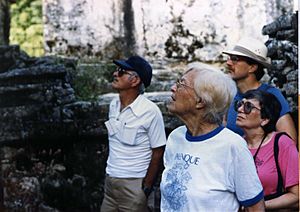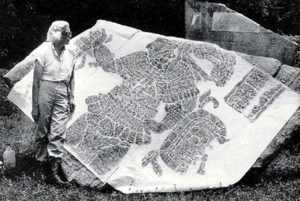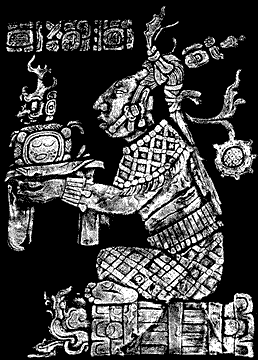Merle Greene Robertson facts for kids
Quick facts for kids
Merle Greene Robertson
|
|
|---|---|

Merle Greene Robertson (foreground), in 1986 at Palenque, during a Mesa Redonda (Round Table) conference.
|
|
| Born | August 30, 1913 |
| Died | April 22, 2011 (aged 97) |
| Nationality | American |
| Education | University of Washington, University of Guanajuato |
| Known for | Painting, art historian |
| Spouse(s) | Bob Robertson |
| Awards | Orden del Pop Award from Guatemala's Museo Popol Vuh |
Merle Greene Robertson (born August 30, 1913 – died April 22, 2011) was an American artist and historian. She was also an archaeologist and a researcher who studied the ancient Maya people. Merle was famous for her work to understand and protect the art, symbols, and writing of the pre-Columbian Maya civilization in Central America. She is best known for her special "rubbings" of Maya carvings. These rubbings helped record important details from Maya stone carvings, especially at sites like Tikal and Palenque.
Contents
Early Life and Learning
Merle Greene Robertson was born in 1913 in Miles City, Montana. When she was very young, her family moved to Great Falls, Montana. There, she became very interested in Native American culture. She even learned Indian sign language from Blackfoot Indian chiefs. These chiefs were good friends with her father.
In Great Falls, Merle also met a famous artist named Charles M. Russell. He spent many afternoons teaching Merle how to paint. When she was a teenager, Merle moved to Seattle, Washington. She finished high school there and then went to the University of Washington.
Her Adult Life
After college, Merle worked as a commercial artist. She painted designs on windows using gold leaf. During the summers, she worked at a camp called Camp Tapawingo. Merle later married her college boyfriend, Wallace McNeill Greene. They had two children, David and Barbara. After some years, her marriage ended.
Merle and her children then moved to California. She started teaching at San Rafael Military Academy. There, she met Bob Robertson, who was the dean of the school. They later got married. Merle and Bob traveled to El Salvador to learn about archaeology. Merle then decided to go back to school. She moved to San Miguel de Allende, Mexico.
She earned her Master's degree in Fine Arts from the Universidad de Guanajuato. This is a university in Mexico. She studied painting, photography, and mural art there. Her teacher was a top Mexican artist named James Pinto.
After her studies, Merle started working on the Tikal Project in 1961. This project was with the University of Pennsylvania. She spent three summers drawing the buildings of the Central Acropolis at Tikal. Tikal is a very important ancient Maya city. During this time, she also started making her famous rubbings. This art form became a way to record and save information from Maya stone carvings. People suggested she travel through Guatemala to record other ancient sites.
Merle became a leading expert on the Maya. She also kept teaching school in the United States. She and her husband Bob both worked at the Stevenson School in Pebble Beach, California. Here, Merle shared her love of the Maya with young students. She taught a class about Mesoamerican archaeology. She even took many students on trips into the jungles of Central America. Some of her students later studied archaeology in college. They went on to have careers studying the Maya, like the famous Mayanist Arlen F. Chase.
Helping Maya Studies
Amazing Rubbings
Merle Greene Robertson was first trained as an artist. She created a new way to make rubbings from large Maya stone sculptures and writings. Over 40 years, she made more than 4,000 rubbings. About 2,000 of these were from large monuments. These rubbings were very important. They saved details of artworks that have since been damaged or even lost. This damage happened because of weather or people stealing parts of the art.
The ancient Chinese first used this rubbing method. But Merle improved and perfected the process. She developed two techniques using different kinds of ink on rice paper. The type of ink she chose depended on the weather and the stone she was recording. Merle, along with other Maya experts like Tatiana Proskouriakoff, helped women join the field of Maya archaeology. She was the first woman to join the Tikal Project. At that time, it was not common for women to work on archaeological digs.
Merle is most famous for her work at Palenque. Palenque is another very important ancient Maya city. In the 1980s, she started a project to record all the carved art there in great detail. This led to the start of the Palenque Round Table conferences. These meetings brought together experts to share new discoveries about the Maya. They made big steps in understanding ancient Maya writing, called hieroglyphs. The meetings started in 1973 and ended in 1993. Ten books have been published from these meetings.
Merle also worked at Chichen Itza for many years. Chichen Itza is another famous Maya site. There, she made a big report of all the sculptures. She recorded the hieroglyphic writing and the symbols. She also tried to understand the art from the point of view of the artists who made it. This showed her special way of looking at things as an artist, not just an archaeologist.
In 1982, Merle started the Pre-Columbian Art Research Institute. This group publishes the PARI Journal. This non-profit organization helped research Mesoamerican art, writing, and symbols. It also funded archaeological digs at Palenque.
In 2004, Merle received the Orden del Pop Award. This award came from Guatemala's Museo Popol Vuh. It recognized her many years of work to protect Guatemala's Maya heritage. She did this by carefully recording Maya monuments and hieroglyphic writing. Mexico's National Institute of Anthropology and History (INAH) also gave Merle the Order of the Aztec Eagle. They named her Honorary President of the Palenque Round Tables, which still continue today.
Images for kids
See also
 In Spanish: Merle Greene Robertson para niños
In Spanish: Merle Greene Robertson para niños






